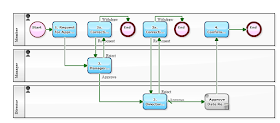
Regarding designation within an organization in which its hierarchy is uneven, we studied "method of absolute specification by job title" in Part 1, and "method of relative designation according to organization hierarchy" in Part 2.
Both methods have advantages and disadvantages, and approver/decision-makers are needed to be careful during operation. After all, in the case of "an organization with unevenness in depth", it is difficult to simply describe business rules.
The easy-to-use and easy-to-operate Workflow (setting method) will also vary depending on the size of the organization or proficiency to business rules/system of the organization members, and so on. Although we will introduce two more Workflows this time, please consider and choose "which description method is easy to operate without misunderstanding" according to the actual situation of each company including those introduced in the past articles.
One way is to separate the Workflows according to the requester.
In other words, if the approval route differs depending on the job title of who made a request, it may be good to separate into different Workflows.
[Approval flow (Separate the request of the Manager)]








